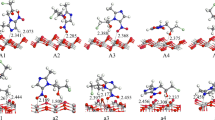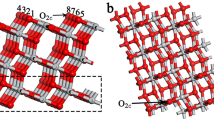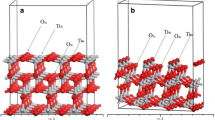Abstract
The adsorption characteristics of metronidazole on anatase TiO2(101) and (001) surfaces were studied by density functional theory (DFT). The adsorption structure of metronidazole on anatase TiO2(101) and (001) surfaces has been optimized under vacuum, water, acidic, and alkaline conditions, respectively. The optimum adsorption site, adsorption energy, and electronic structure of the stable adsorption model were calculated. The adsorption characteristics of metronidazole on two different surfaces of TiO2 were studied under acidic and alkaline conditions. Our calculated results found that the adsorption energy range is −0.95 ~ −3.11 eV on the TiO2 (101) surface, and the adsorption energy range is −0.84 ~ −3.29 eV on the TiO2 (001) surface. The adsorption wavelengths of electron transition between valence band and conduction band of metronidazole on the anatase TiO2(101) surface is in the range of visible wavelength, indicating that the TiO2(101) surface can effectively utilize visible light. However, the photocatalytic effect of the TiO2(001) surface is greatly affected by the environment. The results reveal the adsorption characteristics and the environmental influence for metronidazole on photocatalytic anatase TiO2 surfaces.

The adsorption characteristics of metronidazole on anatase TiO2(101) and (001) crystal surfaces were studied by density functional theory (DFT).






Similar content being viewed by others
References
Lau AH, Lam NP, Piscitelli SC, Wilkes L, Danziger LH (1992) Clinical pharmacokinetics of metronidazole and other Nitroimidazole anti-Infectives. Clin Pharmacokinet 23:328–364
Tally FP, Sullivan CE (1981) Metronidazole: in vitro activity, pharmacology and efficacy in anaerobic bacterial infections. Pharmacotherapy: J Human Pharmacol Drug Therapy 1:28–38
Huang XJ, Lin JB, Yuan DX (2011) Simple and sensitive determination of nitroimidazole residues in honey using stir bar sorptive extraction with mixed mode monolith followed by liquid chromatography. J Sep Sci 34:2138–2144
Granja RHMM, Nino AMM, Reche KVG, Giannotti FM, de Lima AC, Wanschel ACBA, Salerno AG (2013) Determination and confirmation of metronidazole, dimetridazole, ronidazole and their metabolites in bovine muscle by LC-MS/MS. Food Addit Contam Part A 30:970–976
Chen F, Li SY, Peng JD, Wang X, Peng HJ, Chen Y, He Y (2018) Study on simultaneous determination of three nitroimidazole residues in honey by high performance liquid chromatography–resonance Rayleigh scattering spectra. Microchem J 141:423–430
Yuan N, Zhang GK, Guo S, Wan Z (2016) Enhanced ultrasound-assisted degradation of methyl orange and metronidazole by rectorite-supported nanoscale zero-valent iron. Ultrason Sonochem 28:62–68
Neghi N, Kumar M (2017) Performance analysis of photolytic, photocatalytic, and adsorption Systems in the Degradation of metronidazole on the perspective of removal rate and energy consumption. Water Air Soil Pollut 228:339
Sahoo DR, Jain S (2016) A rapid and validated RP-HPLC method for the simultaneous quantification of benzoic acid, metronidazole and miconazole nitrate in vaginal formulations. J Chromatogr Sci 54:1613–1618
Kim SH, Shon HK, Ngo HH (2010) Adsorption characteristics of antibiotics trimethoprim on powdered and granular activated carbon. J Ind Eng Chem 16:344–349
Ahmed MJ, Theydan SK (2013) Microporous activated carbon from Siris seed pods by microwave-induced KOH activation for metronidazole adsorption. J Anal Appl Pyrolysis 99:101–109
Çalışkan E, Göktürk S (2010) Adsorption characteristics of sulfamethoxazole and metronidazole on activated carbon. Sep Sci Technol 45:244–255
Okhovat N, Hashemi M, Golpayegani AA (2015) Photocatalytic decomposition of metronidazolein aqueous solutions using titanium dioxide nanoparticles. J Mater Environ Sci 6:792–799
Farzadkia M, Bazrafshan E, Esrafili A, Yang JK, Shirzad-Siboni M (2015) Photocatalytic degradation of metronidazole with illuminated TiO2 nanoparticles. J Environ Health Sci 13:35
Besova AS, Vorontsov AV (2015) Sinergistic effect of titanium dioxide and iron oxide aerosols in adsorption and photocatalytic oxidation of dimethyl methylphosphonate. J Phy Chem A 89:693–698
Vorontsova AV, Smirniotis PG (2018) Size and surface groups effects in decahedral anatase nanoparticles for photocatalytic applications. J Photochem Photobiol A 363:51–60
Vorontsov AV, Tsybulya SV (2018) Influence of nanoparticles size on XRD patterns for small monodisperse nanoparticles of Cu0 and TiO2 anatase. Ind Eng Chem Res 57:2526–2536
Besov AS, Vorontsov AV, Parmon VN (2009) Fast adsorptive and photocatalytic purification of air from acetone and dimethyl methylphosphonate by TiO2 aerosol. Appl Catal B Environ 89:602–612
Besov AS, Vorontsov AV (2008) Fast elimination of organic airborne compounds by adsorption and catalytic oxidation over aerosol TiO2. Catal Commun 9:2598–2600
Sun B, Vorontsov AV, Smirniotis PG (2011) Parametric studies of diethyl phosphoramidate photocatalytic decomposition over TiO2. J Hazard Mater 186:1147–1153
Sanzone G, Zimbone M, Cacciato G, Ruffino F, Carles R, Privitera V, Grimaldi MG (2018) Ag/TiO2 nanocomposite for visible light-driven photocatalysis. Comput Theor Chem 123:394–402
O’Rourke C, Bowler DR (2010) Adsorption of Thiophene-conjugated sensitizers on TiO2 Anatase (101). J Phys Chem C 114:20240–20248
Vittadini A, Selloni A, Rotzinger FP, Grätzel M (1998) Structure and energetics of water adsorbed at TiO2 Anatase (101) and (001) surfaces. Phys Rev Lett 81:2954–2957
Agosta L, Brandt EG, Lyubartsev AP (2017) diffusion and reaction pathways of water near fully hydrated TiO2 surfaces from ab initio molecular dynamics. J Chem Phys 147:024704
Rahaman O, van Duin ACT, Goddard WA, Doren DJ (2011) Development of a ReaxFF reactive force field for Glycine and application to solvent effect and Tautomerization. J Phys Chem B 115:249–261
Plimpton S (1995) Fast parallel algorithms for short-range molecular dynamics. J Comput Phys 117:1–19
Sun Q, Yu HT (2018) A density functional theory investigation of the fragmentation mechanism of deprotonated asparagine. Comput Theor Chem 1141:45–52
Higuchi M, Higuchi K (2013) Pair density functional theory. Comput Theor Chem 1003:91–96
Buendia F, Vargas JA, Johnston RL, Beltran MR (2017) Study of the stability of small AuRh clusters found by a genetic algorithm methodology. Comput Theor Chem 1119:51–58
Perdew JP, Burke K, Ernzerhof M (1996) Generalized gradient approximation made simple. Phys Rev Lett 77:3865–3868
Kresse G, Furthmüller J (1996) Efficiency of ab-initio total energy calculations for metals and semiconductors using a plane-wave basis set. Comput Mater Sci 6:15–50
Moellmann J, Grimme S (2014) DFT-D3 study of some molecular crystals. J Phys Chem C 118:7615–7621
Risthaus T, Grimme S (2013) Benchmarking of London dispersionaccounting density functional theory methods on very large molecular complexes. J Chem Theory Comput 9:1580–1591
Wang J, Yang M, Deng D, Qiu S (2017) The adsorption of NO, NH3, N2 on carbon surface: a density functional theory study. J Mol Model 23:262
Dudarev SL, Botton GA, Savrasov SY, Humphreys CJ, Sutton AP (1998) Electron-energy-loss spectra and the structural stability of nickel oxide: an LSDA+U study. Phys Rev B 57:1505–1509
Burdett JK, Hughbanks T, Miller GJ, Richardson JWJ, Smith JV (1987) ChemInform abstract: structural-electronic relationships in inorganic solids: powder neutron diffraction studies of the rutile and Anatase polymorphs of titanium dioxide at 15 and 295 K. ChemInform 18:3639–3646
Zhang L, Liu X, Rao WF, Li JF (2016) Multilayer dye aggregation at dye/TiO2 Interface via π…π stacking and hydrogen bond and its impact on solar cell performance: a DFT analysis. Sci Rep 6:35893
Li N, Fan XL, Tang KY, Zheng XJ, Liu J, Wang BS (2016) Nanocomposite scaffold with enhanced stability by hydrogen bonds between collagen, polyvinyl pyrrolidone and titanium dioxide. Colloids Surf B 140:287–296
Park S, Ahn JS, Sugiyama A, Chi DH (2008) Theoretical study of the effect of a solvent on the adsorption of Pt atom on a graphene surface. J Korean Phys Soc 53:1642–1645
Schneider J, Berger T, Diwald O (2018) Reactive porphyrin adsorption on TiO2 Anatase particles: solvent assistance and the effect of water addition. ACS Appl Mater Interfaces 10:16836–16842
Norton DP (2004) Synthesis and properties of epitaxial electronic oxide thin-film materials. Mater Sci Eng 43:139–124
Thomas AG, Jackman MJ, Wagstaffe M, Radtke H, Syres K, Adell J, Levy A, Martsinovich N (2014) Adsorption studies of p-aminobenzoic acid on the anatase TiO2 (101) surface. Langmuir 30:12306–12314
Yu W, Niu CY, Zhu Z, Wang X, Zhang WB (2016) Atomically thin binary V–V compound semiconductor: a first-principles study. J Mater Chem C 4:6581–6587
Acknowledgments
This project is supported by National Science Foundation of the Sichuan province(2014JY0099).
Author information
Authors and Affiliations
Corresponding author
Additional information
Publisher’s note
Springer Nature remains neutral with regard to jurisdictional claims in published maps and institutional affiliations.
Electronic supplementary material
ESM 1
(DOC 1633 kb)
Rights and permissions
About this article
Cite this article
Qin, Q., Qin, H., Luo, H. et al. Theoretical study of adsorption characteristics and the environmental influence for metronidazole on photocatalytic TiO2 anatase surfaces. J Mol Model 25, 73 (2019). https://doi.org/10.1007/s00894-019-3967-x
Received:
Accepted:
Published:
DOI: https://doi.org/10.1007/s00894-019-3967-x




